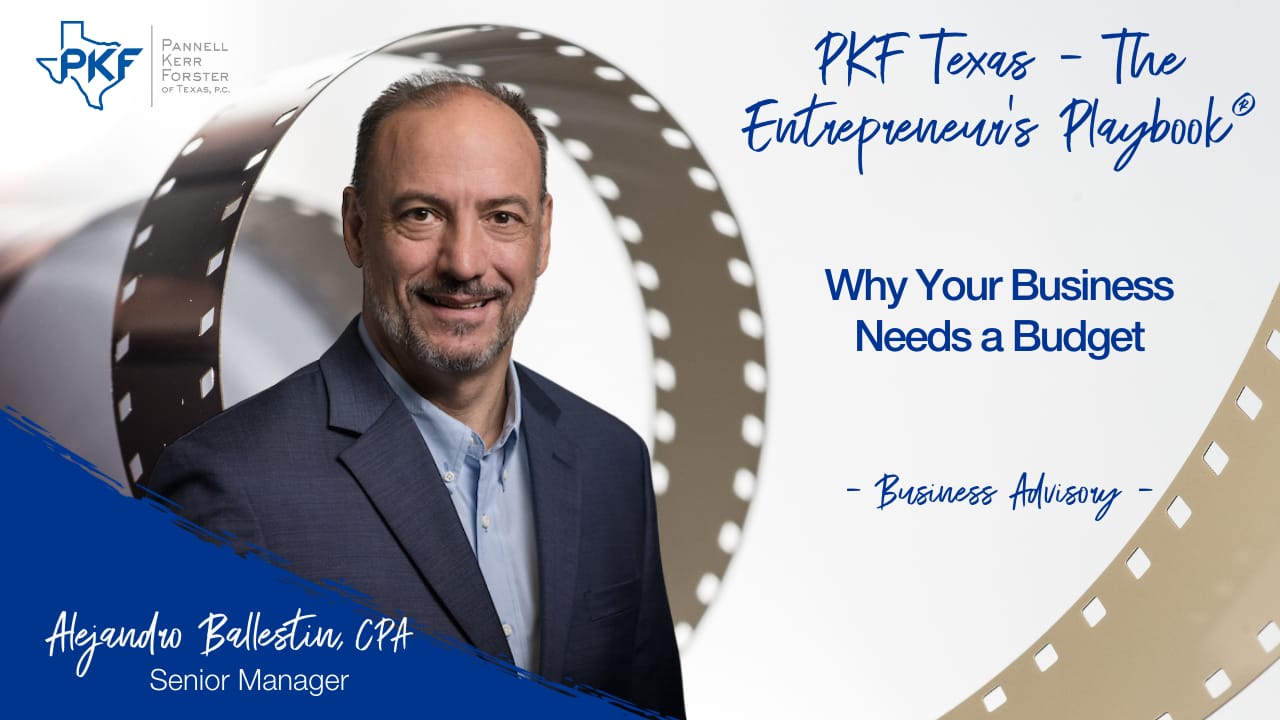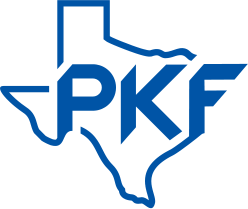Why Your Business Needs a Budget

In this episode of PKF Texas—The Entrepreneurs Playbook®, Jen Lemanski sits down with Alejandro Ballestin, Senior Manager in the Business Advisory group and one of our Approachable Advisor®, to discuss the importance of budgeting for businesses. They explore why small and medium-sized companies often lack formal budgets, how to build a practical budgeting process, the difference between a budget and a forecast, and how businesses can use budgeting as a powerful tool for growth. Whether you’re just starting your first budget or looking to fine-tune your existing process, Alejandro shares valuable insights on how budgeting can improve accountability, resource management, and decision-making.
Transcript Below
Jen: This is the PKF Texas- The Entrepreneurs Playbook®. I’m Jen Lemanski and I’m here with Alejandro Ballestin, one of our senior managers in the Business Advisory group, as well as one of the Approachable Advisors®. here at PKF Texas. Alejandro, welcome to the Playbook.
Alejandro: Thank you for having me. It’s been a pleasure.
Jen: So, I know we advise business advisory, we advise our clients on a lot of different things. And one of those things are kind of like their annual business plan, you know, looking forward, figuring things out. And I know budgeting often plays into that. When you’re making recommendations to our clients, can you share like why is a budget important and do people really not have a budget?
Alejandro: Absolutely. You know, especially in medium and small sized companies, it’s pretty normal to find out that they don’t have a formal budget. Doesn’t mean that they don’t have goals or they don’t coordinate to get their goals. But sometimes they lack the formality of prepare a plan where all the managers, all the departments inside the company share their thoughts and coordinate their efforts.
And doing that helps for many, many things. First is good for accountability because when you set goals and everyone knows what the goals are for the company, you can determine in the middle of the year or during any period of time if you are below or under or about your projects. Another thing that is important is to coordinate resources because typically most of the companies has a very clear vision of what the sales budget would be and the goal of sales.
They understand their clients, they understand their products and they can figure it out the sales part of the budget. But also it’s good that the other departments know about the plan. Right, because they need to coordinate resources like capacity in the plan purchases, human resources, financial resources, technology. And you know, for example, you need to coordinate if the sales budget is growing a lot.
Probably you have to evaluate capital expenditures. You need to evaluate if you need to expand your plant or if you need to add another shift in your manufacturing area. Sure, many things. And you know, if you any impact that you have in your company sooner or later is going to affect your cash flow.
For example, if you don’t coordinate with the manufacturing area of purchasing, the typical reaction to not have enough information is cushion you, cushion you buy just in case. Because you don’t want to be in the position if you are the manufacturing manager or the purchasing responsible to not to have the products if the salespeople need them.
But on the other hand, you don’t want to be overstocked, you don’t want.
Jen: To have all that excess inventory that’s just sitting there that then you can’t move.
Alejandro: And then you have cost your money. You know, it distracts your financial resources in areas that you don’t need to. And the same applies for human resources. You need to understand how many people you need and you don’t want to be over or below your needs. You have to be sensitive to these kind of things.
And of course you can review it. You can review the plan every quarter, every month, depending on your need.
Jen: So who do you get involved in that budgeting process? Is it the owner of the company plus the department heads, or who do you typically see as part of that process?
Alejandro: Typically, you first discuss their strategic plan. You start from the leadership of the company. The owners, they define where they want to go. Typically the process is sales, manufacturing, purchasing, human capital, and then at the end, the finance people, just to see how the cash looks. That is the typical process facing the market first.
And also you have to get some information from your market, what are the trends, because you don’t want to keep doing things that the market is not demanding. You have to listen your market and then adjust all the resources, internal resources, to get that goal. That is the typical process.
Jen: If they’re not running with a formal budget, where do they start? Are there like templates online? Do they call somebody like us in to kind of help walk them through that process? What have you seen?
Alejandro: According to my experience, there are different software that help you with the budget. But in my experience, in our experience is that each company has their own ways to do things. We like to go from the dollar sign to quantity, price, cost. And our approach is customize the need to our client. We can go from simple spreadsheets to try to implement an application that help.
Jen: You with the budgeting process type thing.
Alejandro: You typically feed the ERP with your spreadsheets or your calculations. Yeah, true.
Jen: Yeah. So how does a budget. Is it one of those things where once you set the budget, it is set in stone and then you’re never touching it until the next year? Or is it kind of a living and breathing type thing?
Alejandro: That is a typical question because people don’t understand some jargon like a budget and forecast. This is the typical difference between the budget and a forecast. The budget typically called the annual plan and you don’t change the budget. That was the goal that you set a year in advance or a couple of months in advance.
This time of the year, October, November is when the company discussed the budget of the next year. Then the forecast is a combination of your budget original plus the actual information that you have. For example, if the first quarter pass, you put the first quarter as an actual information and then adjust the next 90 months to finish the year.
That is the typical forecast because you have to adjust and you have to have a plan B. What happens if you are 10% more or 10% less? You don’t need to expand or to buy the thing that you define in the budget if the trend or the market is showing you that you are over or you are short.
But of course you have to review it. Some companies do it weekly, some companies do it monthly or quarterly. Depends on the dynamic of the company, the cycle.
Jen: So it’s really kind of a measurement tool as well.
Alejandro: Of course, of course we have a say internally that you cannot improve whatever you don’t measure and you have to measure. And we were talking before this conversation about the human nature that the people doesn’t like to put a number in the budget because nobody want to be judged. Then that you miss the target you missed budget.
Yeah, but that is not the intention. The intention is to measure the variances and to learn to learn from the reality. You put a goal and then you learn why you missed. And if you have to adjust in the future.
Jen: Well, it sounds like we’ve got a lot more to dive into. I’m sure there’s other tools that you like clients to look at and we’ll get you back to talk about some of those in the future. Sound good?
Alejandro: Absolutely. I love it.
Jen: Great. This has been another Thought leadership production brought to you by PKF Texas, the Entrepreneur’s Playbook. For more information about this and other topics, visit pkftexas.com/insights. Tune in next week for another chapter.
